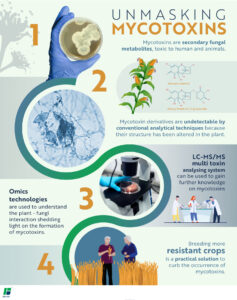More than 500 mycotoxins are identified and out of that 50 are analyzed in the laboratory. Majorly mycotoxins are categorised into 5 groups- Aflatoxin, Ochratoxin, Fumonisin, Zearalenone, Trichothecene.
Out of these mycotoxins, few are identified as masked mycotoxins. In 1990, Manfred Gareis used the term “masked mycotoxins” for the first time. Masked mycotoxins are formed when plants metabolise mycotoxins, as part of their natural defence system. The metabolites are termed as masked because they become toxic again when they cleave off their sugar molecule in the intestine of the animal.
Masked mycotoxins easily pass through standard mycotoxins test procedures unless high precision tests like LC-MS/MS are performed to detect. Studies for DON-3-glucoside (masked mycotoxin) in rodents and piglets showed the same toxicity level as the actual DON caused.

Plant breeders and scientists in the field of phytogenomics are in a quest to breed crops which can metabolise mycotoxins even better. The side effect though, is that the proportion of masked mycotoxins becomes more prominent in crops. This means that with breeding for more resistant crops, a greater percentage of the total mycotoxin load is masked which is alarming for livestock producers .
A high precision analytical standard for detecting masked mycotoxins in feed and crops is of paramount importance. However, most of these compounds are not commercially available for routine testing.
As a standard mycotoxin control programme, along with stringent quality control practices, usage of broad spectrum mycotoxin binder which can even bind and sequester masked mycotoxins in feed. Bentoli’s FixarⓇ Bios could be the best solution to offer broad spectrum binding of all major mycotoxins and its secondary plant metabolites.


